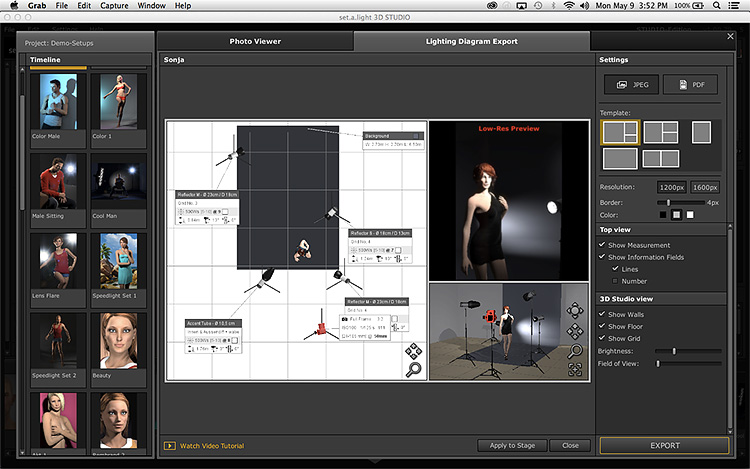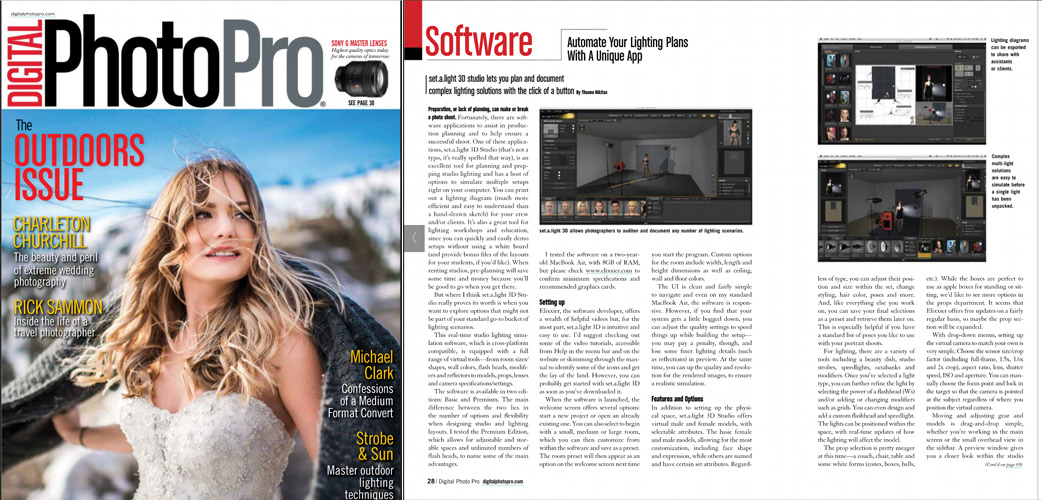
Automate Your Lighting Plans With A Unique APP!
“set.a.light 3D Studio lets you plan and document complex lighting solutions with the click of a button.”
set.a.light 3D allows photographers to auditon and document any number of lighting scenarios.
Preparation, or lack of planning, can make or break a photo shoot. Fortunately, there are software applications to assist in production planning and to help ensure a successful shoot. One of these applications, set.a.light 3D Studio (that’s not a typo, it’s really spelled that way), is an excellent tool for planning and prepping studio lighting and has a host of options to simulate multiple setups right on your computer. You can print out a lighting diagram (much more efficient and easy to understand than a hand-drawn sketch) for your crew and/or clients. It’s also a great tool for lighting workshops and education, since you can quickly and easily demo setups without using a white board (and provide bonus files of the layouts for your students, if you’d like). When renting studios, pre-planning will save some time and money because you’ll be good to go when you get there.
But where I think set.a.light 3D Studio really proves its worth is when you want to explore options that might not be part of your standard go-to bucket of lighting scenarios.
This real-time studio lighting simulation software, which is cross-platform compatible, is equipped with a full range of virtual tools—from room sizes/shapes, wall colors, flash heads, modifiers and reflectors to models, props, lenses and camera specifications/settings.
The software is available in two editions: Basic and Premium. The main difference between the two lies in the number of options and flexibility when designing studio and lighting layouts. I tested the Premium Edition, which allows for adjustable and storable spaces and unlimited numbers of flash heads, to name some of the main advantages.
Setting up
elixxier, the software developer, offers a wealth of helpful videos but, for the most part, set.a.light 3D is intuitive and easy to use. I’d suggest checking out some of the video tutorials, accessible from Help in the menu bar and on the website or skimming through the manual to identify some of the icons and get the lay of the land. However, you can probably get started with set.a.light 3D as soon as you’ve downloaded it.
When the software is launched, the welcome screen offers several options: start a new project or open an already existing one. You can also select to begin with a small, medium or large room, which you can then customize from within the software and save as a preset. The room preset will then appear as an option on the welcome screen next time you start the program. Custom options for the room include width, length and height dimensions as well as ceiling, wall and floor colors.
The UI is clean and fairly simple to navigate and even on my standard MacBook Air, the software is responsive. However, if you find that your system gets a little bogged down, you can adjust the quality settings to speed things up while building the setup—you may pay a penalty, though, and lose some finer lighting details (such as reflections) in preview. At the same time, you can up the quality and resolution for the rendered images, to ensure a realistic simulation.
Features and Options
In addition to setting up the physical space, set.a.light 3D Studio offers virtual male and female models, with selectable attributes. The basic female and male models, allowing for the most customization, including face shape and expression, while others are named and have certain set attributes. Regardless of type, you can adjust their position and size within the set, change styling, hair color, poses and more. And, like everything else you work on, you can save your final selections as a preset and retrieve them later on. This is especially helpful if you have a standard list of poses you like to use with your portrait shoots.
For lighting, there are a variety of tools including a beauty dish, studio strobes, speedlights, octabanks and modifiers. Once you’ve selected a light type, you can further refine the light by selecting the power of a flashhead (Ws) and/or adding or changing modifiers such as grids. You can even design and add a custom flashhead and speedlight. The lights can be positioned within the space, with real-time updates of how the lighting will affect the model.
The prop selection is pretty meager at this time—a couch, chair, table and some white forms (cones, boxes, balls, etc.). While the boxes are perfect to use as apple boxes for standing or sitting, we’d like to see more options in the props department. It seems that Elixxier offers free updates on a fairly regular basis, so maybe the prop section will be expanded.
With drop-down menus, setting up the virtual camera to match your own is very simple. Choose the sensor size/crop factor (including full-frame, 1.5x, 1.6x and 2x crop), aspect ratio, lens, shutter speed, ISO and aperture. You can manually choose the focus point and lock in the target so that the camera is pointed at the subject regardless of where you position the virtual camera.
Moving and adjusting gear and models is drag-and-drop simple, whether you’re working in the main screen or the small overhead view in the sidebar. A preview window gives you a closer look within the studio but can be switched to the main screen, which I found was very helpful for setting focus points. There’s also a set list with all the current gear, props and models that makes it one-click simple to select an object to modify or remove, which is especially helpful when working with complex lighting setups.
Operation
There’s more functionality than meets the eye with this software. You can duplicate objects, models and light shapers, for example. And, for a more precise setup when you leave the virtual studio and move into the real one, a dimensioning tool can be drawn between objects and models within the software so you’ll know exact positioning to replicate the scene. And because this is 3D software, you can easily navigate the studio and even do a roundabout with the Orbit tool to make sure everything’s in place before you finish up.
During the shoot, you can take snapshots each time you change a parameter or position. These snapshots are shown in the timeline and allow you to get back to the image’s specific studio set. Rendering all images is one-click simple. More importantly, you can choose an image from the timeline and export the set plan to a PDF. You can also add your own notes and metadata to the set plan to have full information on hand when you’re setting up in the studio.
Bottom Line
Although I didn’t touch on every single feature and function of this software, I think it’s easy to see how useful set.a.light 3D can be whether you’re a studio lighting pro, someone who wants to move from the basics into more complex lighting configurations or an enthusiast just starting to experiment with studio lighting.
With a diverse collection of lighting options—and the ability to add custom lights—the software should match up with even well-equipped studios. And, with the ability to create your own models, most scenarios are covered. Elixxier may, however, want to add some child and teen model avatars to help out the family portrait photographers. There is an option for pregnant figures, so the increasingly popular pregnancy genre is covered there. Fine art photographers will appreciate the option for nude figures, too.
There’s a 30-day free trial, so it’s easy to spend some time evaluating the software for your needs. But I think you’ll find that it’s well worth the price given the time and effort it will save you when you’re on a shoot. And, the software is actually kind of fun to play with, so it might just boost your creative approach to lighting as well.
Freelance writer and photographer Theano Nikitas has been covering the photo industry for more than 20 years. Her digital imaging reviews, features, tutorials and images have appeared in a variety of print and electronic publications and books.
http://www.digitalphotopro.com/software/image-processing-software/automate-lighting-plans-app/
This post is also available in: German
 elixxier – Photo Blog Light settings and lighting structures for studio and outdoor photography. Tips and tricks for set.a.light 3D – The photo studio and light simulation for photographers.
elixxier – Photo Blog Light settings and lighting structures for studio and outdoor photography. Tips and tricks for set.a.light 3D – The photo studio and light simulation for photographers.



